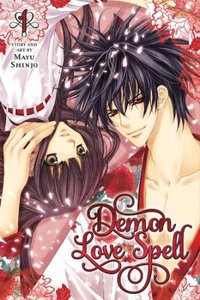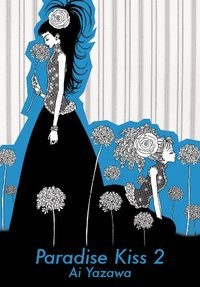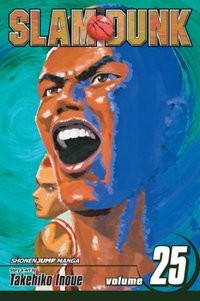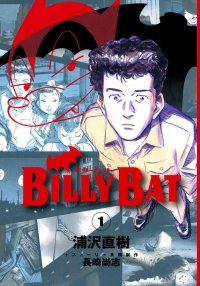RIGHT TURN ONLY!!
Demons in Paradise
by Carlo Santos,

The days grow shorter, the weather grows colder, and much like Grizzly in the Polar Bear Cafe series, I'm thinking hibernation would be a good idea. Just wake me up in time to gorge on the Christmas feast that my relatives put together every year.
DEMON LOVE SPELL

Vol. 1
(by Mayu Shinjo, Viz Media, $9.99)
FROM THE BACK COVER:
"Miko is a shrine maiden who has never had much success at seeing or banishing spirits. Then she meets Kagura, a sexy demon who feeds off women's feelings of passion and love. Kagura's insatiable appetite has left many girls at school brokenhearted, so Miko casts a spell to seal his powers. Surprisingly the spell works—sort of—but now Kagura is after her!"
EVIDENCE FOR:
You would, Mayu Shinjo. You would do something ridiculous like this. Demon Love Spell crosses over the straightforward genres of spirit-battling action with everyday-girl-meets-bad-boy romance—and gets something hilariously twisted out of it. The series never wastes an opportunity for humor, whether it's poking fun at Miko's spiritual ineptness, playing up Kagura's insatiable sexual appetite, or even cracking a raunchy joke about getting it on with hamsters. Then comes the real drama: the middle part of this volume introduces an equally handsome, equally demonic rival, because the only thing more fun than a mismatched couple is a mismatched love triangle. But don't think this is just a cookie-cutter romance manga with supernatural themes tacked on—fending off demons and increasing one's spiritual powers are all essential to the plot, as they connect to the ups and downs of Miko and Kagura's relationship. Aside from the story itself, there's also plenty of visual appeal with all the dangerously good-looking male protagonists. Shinjo also steps outside her usual genre boundaries, illustrating a number of battle scenes where magical incantations take form and blasts of energy light up the page.
EVIDENCE AGAINST:
Maybe Shinjo should have stayed within her genre boundaries. The art in Demon Love Spell, especially during action scenes, is the series' most obvious weakness. There's no sense of movement, and not much energy to the characters' gestures: they spend most of their time yelling or pointing at each other, with pre-fabricated special effects pasted onto the image. Even the part of the artwork that ought to be a gimme—the lovey-dovey interludes—are less than convincing. Miko and Kagura's moments together consist of predictable poses that could have come out of any other romance series, and the panel composition is simple to the point of boredom: here's two characters interacting, here's the dialogue between them, and forget about the backgrounds. The story, meanwhile, fails to live up to the true potential of mashing two common genres together. Rather than a truly ingenious mix-up, you just get all the romantic clichés ("He loves her ... he loves her not ... he loves her?") and all the supernatural-action clichés (Fight evil monsters! Save the day!) rolled into a single storyline. It's like getting two mediocre manga volumes for the price of one, and who wants that?
FINAL VERDICT:
A cute attempt with occasional bursts of goofy humor, but between the overdone story tropes and lackluster art, this isn't much more than a C+.
THE KUROSAGI CORPSE DELIVERY SERVICE

Vol. 13
(by Eiji Otsuka and Housui Yamazaki, Dark Horse, $12.99)
FROM THE BACK COVER:
"Old friends and enemies alike return as Sasaki and Karatsu step off the plane from Okinawa—right into a gruesome scheme of zombification both traditional and technical, courtesy of the sinister Shirosagi duo! Then, one man's freedom depends on Sasaki, as she's called to serve as a lay judge in Japan's unique trial system ... and where the pressure is on to reach the 'correct' verdict ... "
EVIDENCE FOR:
Kurosagi Corpse Delivery Service is always worth the wait—especially when it combines supernatural crime-solving, social commentary, and general knowledge like this volume. The first-half story arc is a twisting, turning masterpiece: it starts out all cryptic and shocking, ventures into the realm of cutting-edge brain technology, then questions the dangers of dealing out vigilante justice against internet creeps. The second story is shorter but no less impressive, with its cynical take on Japan's rigid legal system and the clever use of synesthesia (there's a lot more to it than just "hearing colors") as a plot device. Oh, and just in case all that wasn't mind-bending enough, the one-and-done chapter dives deep into anthropology, with some fertility folk tales and a murder mystery linked to Japan's ancient past. No matter what the subject matter, the artwork is as polished as ever: there's no mistaking any of the distinctive, cleanly drawn characters, and the climactic panels—with highly detailed bodies and anatomically correct gore—inspire admiration and digust all at the same time. While the visual style is usually cool and understated, this volume also works in a few worthy action sequences.
EVIDENCE AGAINST:
At the end of the third chapter, there's a casual mention of the rival Shirosagi faction as they quietly spy on the Kurosagi group—but this potential development doesn't go anywhere. They even bring up some intriguing points about Karatsu's powers ... which are never mentioned again. Come on, just once do something with the main characters instead of drumming up all these episodic stories! Yet even the individual episodes sometimes miss the mark. In the first story arc, there's some fancy science that explains how a certain form of mind-control works—but it patches up the far-fetched parts with "and then there were zombie powers" logic. Granted, the series relies on both rigorous research and out-there supernaturalism, but mixing the two in such a contrived manner doesn't work. Another contrivance comes up in the courtroom storyline, when it pulls out the "dying victim's last words" gimmick—I always wonder how someone being murdered has enough time to think up those cryptic clues in advance. Sometimes it feels as if writer Eiji Otsuka is just trying to show off how damned clever his plot twists are.
FINAL VERDICT:
Despite a few missteps in the plot, the series is still full of unique, brain-tickling ideas and quality artwork. Credit this volume with a B+.
MAYO CHIKI!

Vol. 1
(by Hajime Asano and NEET, Seven Seas, $12.99)
FROM THE BACK COVER:
"Sakamachi Kinjiro is a 'normal' seventeen-year-old boy who happens to suffer from an abnormal fear of women, otherwise known as gynophobia. His phobia, which surfaces as an occasional nosebleed, has been kept more or less under control ... until now.
A fateful visit to the school bathroom turns Kinjiro's world upside down, as he discovers the dashing and popular Konoe Subaru is actually a girl?! What's worse, the principal's cruel and domineering daughter, Suzutsuki Kanade, has every reason to keep this secret from leaking out, and makes it her life's work to torment Kinjiro, while attempting to cure his gynophobia.
Is Kanade simply sadistic or does she really want to help Kinjiro overcome his fears? It makes no difference to poor Kinjiro, because his life has just become a living hell."
EVIDENCE FOR:
It's all about the inside game with Mayo Chiki!—and by that I mean the main characters' psychological defects. Whether it's an irrational fear of women (Kinjiro), insecurity and a lack of self-worth (Konoe), or a sadistic desire to mess with the minds of others (Suzutsuki), everyone's got a personal issue that leads to comical interactions and biting dialogue. The first chapter gets off to an energetic start right away, with Kinjiro being chased and violently attacked by Konoe because of his ill-timed "discovery." It only gets funnier when little sister Kureha becomes witness to what's going on—and romantic implications start to crop up between Kinjiro and the other girls. But the series has other dimensions to it as well: the last couple of chapters deliver some pretty serious drama, as well as snippets of back-story that explain these odd relationships. Clean panel layouts and simple character designs make the artwork easily readable and fast-paced, while uptempo action scenes (whether slapstick or serious) add visual interest. Needless to say, the slickly-drawn fanservice also adds visual interest—albeit in a rather different way.
EVIDENCE AGAINST:
Okay, let's say you can get past the dubious premise of Kinjiro developing a nosebleed the moment he comes in contact with a female. Then would you also believe that an heiress and her butler are both attending his school? And that the butler is a cross-dresser who attaches herself to the main character in order to keep the secret under wraps? Would you also believe one of the upcoming plot points involves a kidnapping by a wolf-headed thug? Simply put, this series relies on too many unlikely situations. Trying to shoehorn all these weirdos into a single story isn't necessarily funny—it just makes readers notice how completely unbelievable it is in the first place. Worse yet, Mayo Chiki! uses tired old comedy gimmicks along the way, like the boy-falls-on-top-of-girl trick and the inevitable swimming pool visit. The artwork is also too plain to really be enjoyable: in the middle chapters the various characters spend so much time chatting with each other that all their faces start to look the same, and elsewhere the backgrounds and textures are so bland that slapstick action and cute girls really are the only thing the series has going for it.
FINAL VERDICT:
The flawed characters are amusing, but the hard-to-believe story and unoriginal romantic-comedy situations—as well as mediocre art—are C- material.
PARADISE KISS

Vol. 2
(by Ai Yazawa, Vertical, $19.95)
FROM THE BACK COVER:
"As the Yaza Arts crew races to complete the dress in time for the school fashion show, Yukari takes her future into her hands as a lucky break into the world of modeling gives her the courage to set out on a new path. Yukari has to navigate the grown-up world of professionals while also struggling to find her footing in her tumultuous relationship with George. Will she be able to meet his lofty standards while still being true to her own heart?"
EVIDENCE FOR:
Volume 2 of Paradise Kiss is even more addictive than the first, as Yukari continues to fast-track her way into the fashion business. The first half is an exuberant celebration of youth: leaving home to follow one's dreams, falling in love (and making love), and discovering opportunities that once seemed inaccessible. But then reality hits—and that's where Paradise Kiss proves itself to be a truly well-rounded story. Yukari's neglect of her studies finally catches up with her, sidelined characters re-enter the picture, and the later chapters turn things around in a way few might have expected. Of course, George remains as charming and enigmatic as ever, and the ParaKiss supporting cast are a lot of fun, but it's really all about Yukari's story and her decisions now. The idiosyncratic art also imbues the series with its own special personality: the characters and their outfits give off the vibe of a glamorous otherworld few can enter, while the busy backgrounds reflect the frantic, creative lives that they lead. But some of the manga's finest moments come when everything else cuts away, leaving only the main characters and the look in their eyes as they face uncertain emotions.
EVIDENCE AGAINST:
The characters and their personalities are intriguing, but are they likable? Oftentimes the answer is no, which makes the story needlessly irritating. George is the worst offender here, saying and doing cold things that just make you want to throw the book against the wall. (That's probably the point, but having a leading man like that must be some kind of emotional sado-masochism.) Meanwhile, Yukari's constant habit of narrating every thought in her head gets pretty wearisome after a while. It's also hard to root for a protagonist who basically has everything handed to her: a modeling gig, professional contacts, and the inside track to some of the industry's elite institutions. It's like the "friendship, effort and victory" formula minus the effort, which makes her seem annoying and spoiled. Some might also point to a lack of effort in the art, where once again reference photographs are adapted into cheap, tacky backgrounds that clash with the overall style. The way panels are drawn right next to each other, with no dividing gutters, can also make the pages look cluttered.
FINAL VERDICT:
Despite some character quirks and messy visuals, this rollercoaster coming-of-age story is unique and satisfying in many ways. Chalk up a B for this volume.

Vol. 25
(by Takehiko Inoue, Viz Media, $9.99)
FROM THE BACK COVER:
"After watching a video of Sannoh's semifinal game from the previous year, the Shohoku players, except Sakuragi of course, are feeling nervous—three of Sannoh's starters this year played on that championship team. To make things worse, the stands are filled with Sannoh supporters eager to see their favorite rack up an easy win against Shohoku. But Coach Anzai's been here before and he knows his players, instructing them to lead off with a surprise attack that lets Sannoh know that Shohoku's in the house, and they aren't going out without a fight!"
EVIDENCE FOR:
There's no better sports scenario than having the underdog take on a heavy favorite—and Volume 25 of Slam Dunk carefully stresses just how big the showdown is going to be between Shohoku and Sannoh. The opening scenes of this story arc will open readers' eyes to the psychological side of sports: the players watching footage of Sannoh and gaping in awe, the coach subtly trying to pump up his guys and calm their fears, and even a little pre-game showboating where Sakuragi—forever the joker—helps his teammates loosen up in a dramatic way. And if that seems fun, just wait until the game actually starts: a "surprise attack" play and an amusing secret signal between teammates makes for instant entertainment, and it's only the first few minutes! Of course, Inoue's skillful artwork adds to the impact: the basketball scenes are always precisely drawn yet full of life, and he never overlooks details like shading, clothing wrinkles, and even Sakuragi's gradually-growing hair. Split-second poses flow smoothly from one panel to the next, making the game feel like it's happening in real time—and making fans wish it was possible to fast-forward to the next volume already.
EVIDENCE AGAINST:
There's nothing wrong with a prepatory story arc that builds up hype about the Shohoku-Sannoh matchup—but there is something wrong about how it drags on for almost 150 pages. By about midway, this volume feels like a repetitive exercise: "Yep, Sannoh's good, they're really good, look at how good these guys are." Then they even get into discussing the Sannoh players' abilities, which would probably work better if it were worked into the actual game—Show, don't tell—and we could at least have the excitement of Shohoku working out their counter-strategy on the spot. Instead, the action is put off until the last two chapters, and a handful of interludes where other heavyweight teams dispose of their cupcake opponents doesn't really make up for it. (The only thing worse than a blowout is clips from a blowout...) Because the story spends most of its time in setup mode, the visual highlights in the first few chapters are also less thrilling: it's mostly non-Shohoku players showing off their skills, condensed into little bursts of action that lack the flow of the main game.
FINAL VERDICT:
Even though it drags with all the pregame preparation, it's still good stuff—and gets much better once the main matchup actually starts. Top-notch art and a promising story earn a B+ here.

BINBOGAMI GA!

Vol. 1
(by Yoshiaki Sukeno, Shueisha, ¥460)
FROM THE ENCYCLOPEDIA:
"Pretty, busty rich girl Sakura Ichiko has been blessed with an inordinate amount of good fortune, so much so that she's actually sucking the fortune from those around her. To correct that massive imbalance, Momiji, a God of Misfortune, has come to Earth to 'treat' Sakura—only Sakura isn't so willing to cooperate. As part of an ongoing effort to remedy the problem, Momiji starts living with Sakura."
EVIDENCE FOR:
When it comes to manga about traditional Japanese gods, it usually involves either amped-up battle or slice-of-life wistfulness. So maybe it was about time we got a comedy so irreverent, it practically pies the genre in the face. That slapstick energy runs all through Binbogami Ga!'s first volume, where Sakura's escapades involve trying to avoid being poked by a giant syringe, saving a child from a raging river, and accidentally summoning all the animals of the Chinese zodiac into her home. Sakura's self-centered personality is also a big part of the humor—she's so used to having everything go her way that she's never looked out for others, and when people call her out on it, her misguided reactions are always good for a laugh. There's also no better foil than Momiji, whose brashness and stubborn desire to neutralize Sakura's luck keep the story moving forward. The physical comedy in this series also benefits from incredibly dynamic art—the numerous pratfalls and violent attacks are so convincing, it's almost like this is a battle manga after all. In addition to those high-octane action scenes, the artwork also excels with Momiji's wacky wardrobe choices and her cute mascot-like sidekicks.
EVIDENCE AGAINST:
Binbogami Ga! may have its fun moments, but the rest of the time it's just a lowbrow mess. Then again, what could one expect from a series that cracks a boob-size joke by Page 3? From that point, the story just keeps churning out predictable tropes, like Sakura being the most admired girl in school, learning a valuable life lesson when she has to help out a poor kid, and stepping up the conflict with Momiji when she comes in possession of a magical sword. And it's not like Momiji brings anything terribly original to the series either: her style of comedy basically centers on screaming at Sakura and repeatedly cooking up new schemes to outsmart her. Not much better than a cat-and-mouse cartoon, really. The art also fails to accomplish anything great outside of the comedy punchlines: Sakura and her schoolmates are all pretty ordinary in the character design department, while scenes of everyday life are usually presented in dull "they did this, and then they did this, and then she said that" page layouts. A true artist should put in the effort for all the visuals, not just the laugh-out-loud parts.
FINAL VERDICT:
It may not be a work of genius, but it charges forward with 100% energy and a desire to extract every laugh possible out of a situation. Kind of like Momiji herself—which is certainly amusing enough.

What do you do when one of manga's most acclaimed artists has something important to say about the business? You sit up and pay attention, of course. Please welcome back loyal reader and Reader's Choice contributor, Black Mokona, who shines the spotlight on this "manga about manga" (and comics in general).
What kind of manga makes you sit up and pay attention? Send in a Reader's Choice review of your own, it could soon end up right here in this column!
BILLY BAT

(by Naoki Urasawa, Kodansha, ¥620-630 ea.)
Kevin Yamagata draws the titular Billy Bat comic and enjoys its moderate popularity until he discovers that it may have been plagiarized from a manga. When he travels to Japan to investigate his source of inspiration, he is swept up in multiple real life conspiracies spanning across time and continents. They all center around the mysterious Billy Bat that materializes to a select few through drawings, twisting and entwining their lives together, at times cryptic and cynical, at times wry and sympathetic. The manga, then, echoes an unmistakable American noir influence with the hard-boiled detective comic and the haunting ambiguity of the bat and of the subject matter.
But. At the heart of this manga is a writer writing about writing. Urasawa has incorporated writing ideals into his manga before. The mangaka in 20th Century Boys suffer under a regime in which they cannot write what they want to. It is a frustration Urasawa seemed to have shared when he waited ten years to write the series that put his name on the map, Monster. Billy Bat might have stemmed from Urasawa's experience adapting Astro Boy.
Urasawa forgoes the mechanics of writing and jumps right into the controversy of copyrights. After Kevin leaves his comic to assistant Chuck Culkin, the hard-boiled detective bat gets the Disney treatment and becomes a sweet, fun-loving bat version of Mickey Mouse that goes on adventures instead of solving infidelity cases. The new bat is beloved by children all over the world and derided by its original, mature audience. When Kevin returns, he is denied all rights to his creation.
Did he really, though, create Billy Bat? No, and interestingly, Zofu Karama, from whom he "plagiarized," didn't either: Zofu inherited the bat from another mangaka. What these three writers have in common that Chuck Culkin does not is the ability to talk to the bat. It gets inside their heads, and tells them what stories to write.
Instead of drawing a definite line between the transformative and the plagiarism, Urasawa rejects the corporate model spin-offs, which pander to audience, and supports the independent, which continues and respects the spirit of the canon. Later in the manga, the company plots to destroy all other versions of Billy Bat, so theirs is the only one. It mirrors the ridiculous, creativity stifling steps Disney takes to keep tight rein on Mickey.
I like to compare Billy Bat with Bakuman. Bakuman characters write and comment on the writing process so that the story could recycle Shounen Jump staple values. Billy Bat adopts the thriller format so as to say something less conventional and more controversial about the nature of writing. Bakuman emphasizes on creativity by attempting to subvert genre conventions. Billy Bat posits the tradition of ideas living and being adapted.
Is there a hidden gem of manga you'd like to reveal to the world? Is there a piece of garbage that deserves to be bashed in public? Or is there a title that didn't get a fair grade here, and you want to set the record straight?
Now's YOUR chance to be the reviewer! Write a review of about 300-400 words (a little more or less is fine) and include:
- Your name
- Title of manga (and volume no., if applicable)
- Author/Artist
- Publisher
- Briefly describe the story, then explain why this manga is great, terrible, or in between. Be objective, but also be entertaining.
Then send it in to rtoreaders (at) gmail (dot) com (plain text format preferred). One review will be selected out of all the submissions and will be published in the next column. All types of manga and manga-inspired comickry are accepted, from past and present, from Japan and beyond—what matters is that it's the Reader's Choice! NOTE: Submissions may be edited for formatting and grammar.
discuss this in the forum (11 posts) |